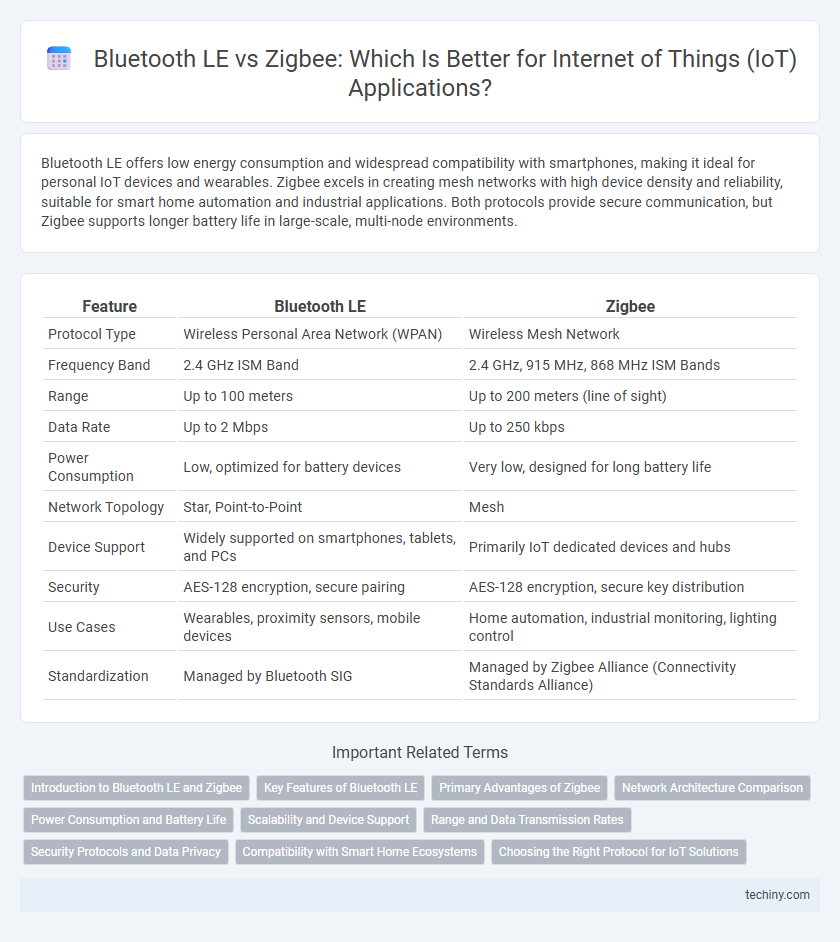Bluetooth LE offers low energy consumption and widespread compatibility with smartphones, making it ideal for personal IoT devices and wearables. Zigbee excels in creating mesh networks with high device density and reliability, suitable for smart home automation and industrial applications. Both protocols provide secure communication, but Zigbee supports longer battery life in large-scale, multi-node environments.
Table of Comparison
| Feature | Bluetooth LE | Zigbee |
|---|---|---|
| Protocol Type | Wireless Personal Area Network (WPAN) | Wireless Mesh Network |
| Frequency Band | 2.4 GHz ISM Band | 2.4 GHz, 915 MHz, 868 MHz ISM Bands |
| Range | Up to 100 meters | Up to 200 meters (line of sight) |
| Data Rate | Up to 2 Mbps | Up to 250 kbps |
| Power Consumption | Low, optimized for battery devices | Very low, designed for long battery life |
| Network Topology | Star, Point-to-Point | Mesh |
| Device Support | Widely supported on smartphones, tablets, and PCs | Primarily IoT dedicated devices and hubs |
| Security | AES-128 encryption, secure pairing | AES-128 encryption, secure key distribution |
| Use Cases | Wearables, proximity sensors, mobile devices | Home automation, industrial monitoring, lighting control |
| Standardization | Managed by Bluetooth SIG | Managed by Zigbee Alliance (Connectivity Standards Alliance) |
Introduction to Bluetooth LE and Zigbee
Bluetooth LE (Low Energy) is a wireless communication technology designed for short-range, low-power connectivity, primarily used in personal area networks for devices like fitness trackers and smart home gadgets. Zigbee operates on a low-power mesh networking protocol, optimized for reliable, scalable device communication over longer distances within home automation and industrial IoT environments. Both technologies support device interoperability but differ in range, power consumption, and network topology, making them suitable for distinct IoT applications.
Key Features of Bluetooth LE
Bluetooth LE offers ultra-low power consumption, making it ideal for battery-operated IoT devices requiring extended lifespan. Its robust support for mesh networking enhances device-to-device communication, improving coverage and reliability in smart home applications. Bluetooth LE also provides high interoperability with smartphones and tablets, facilitating seamless user interaction and widespread adoption in consumer IoT ecosystems.
Primary Advantages of Zigbee
Zigbee excels in low power consumption and robust mesh networking capabilities, making it ideal for large-scale IoT deployments requiring extended battery life and reliable communication between numerous devices. Its standardized protocol ensures interoperability across a wide range of products, facilitating seamless integration and expansion in smart home and industrial automation environments. Zigbee operates in the 2.4 GHz frequency band with a greater range and higher node capacity compared to Bluetooth LE, supporting complex topologies with improved network resilience.
Network Architecture Comparison
Bluetooth LE employs a star network topology where devices communicate directly with a central hub, optimizing low power consumption and simple device management. Zigbee utilizes a mesh network architecture, allowing devices to relay data through multiple nodes, enhancing coverage and reliability in larger IoT deployments. This fundamental difference in network structure influences device scalability, range, and robustness in smart home or industrial applications.
Power Consumption and Battery Life
Bluetooth LE offers ultra-low power consumption optimized for devices requiring long battery life, often lasting several years on a single coin cell battery. Zigbee also provides low power consumption but is designed for mesh networking, enabling devices to relay messages and thereby extending overall network battery efficiency. Battery life depends on usage patterns, with Bluetooth LE excelling in point-to-point connections and Zigbee favored in scalable, multi-node IoT environments.
Scalability and Device Support
Bluetooth LE supports up to 2,000 devices in a mesh network, making it suitable for moderate scalability in IoT applications, while Zigbee excels with support for up to 65,000 nodes, ideal for extensive device networks. Zigbee's robust protocol ensures reliable communication and low latency across large-scale smart home and industrial IoT deployments. Bluetooth LE offers broader device compatibility across smartphones and wearables, whereas Zigbee provides specialized device interoperability optimized for sensor and control systems.
Range and Data Transmission Rates
Bluetooth LE typically supports a range of up to 100 meters with data transmission rates reaching 2 Mbps, making it suitable for short to medium-range IoT applications. Zigbee offers a longer range, generally up to 300 meters in open space, but with lower data rates around 250 kbps, optimized for low-power devices in mesh networks. Choosing between Bluetooth LE and Zigbee depends on specific IoT requirements for coverage area and data throughput.
Security Protocols and Data Privacy
Bluetooth LE employs AES-128 encryption with frequent key refreshes to secure data transmission, supporting secure pairing methods like Just Works and Passkey Entry for device authentication. Zigbee utilizes the IEEE 802.15.4 standard with AES-128 encryption and offers a hierarchical trust model that enables centralized key management, enhancing network-wide security. Both protocols emphasize data privacy, but Zigbee's mesh topology combined with its centralized security approach provides stronger resistance against unauthorized network access compared to Bluetooth LE's point-to-point encryption.
Compatibility with Smart Home Ecosystems
Bluetooth LE offers widespread compatibility with most smartphones and tablets, making it ideal for direct user control in smart home ecosystems like Apple HomeKit and Google Home. Zigbee excels in device-to-device communication within mesh networks, supporting robust interoperability among various sensors, lights, and switches from diverse manufacturers. Smart home platforms increasingly integrate both protocols to leverage Bluetooth LE's user accessibility and Zigbee's network stability.
Choosing the Right Protocol for IoT Solutions
Bluetooth LE offers low power consumption and widespread compatibility, making it ideal for consumer IoT devices requiring direct smartphone interaction. Zigbee excels in creating robust mesh networks with extended range and reliability, suitable for complex home automation and industrial IoT deployments. Selecting the right protocol depends on application needs such as network size, power efficiency, data throughput, and device interoperability.
Bluetooth LE vs Zigbee Infographic

 techiny.com
techiny.com